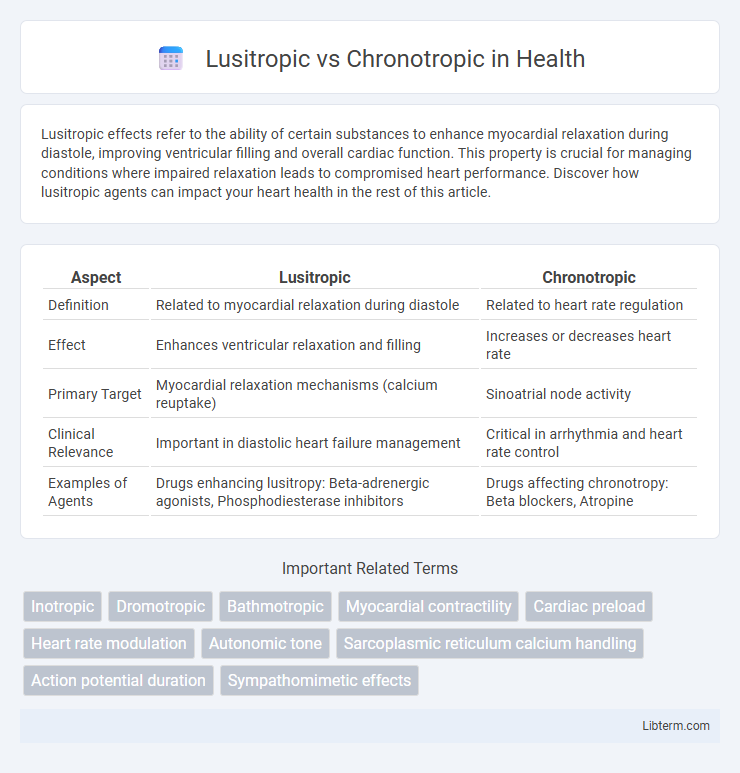Lusitropic effects refer to the ability of certain substances to enhance myocardial relaxation during diastole, improving ventricular filling and overall cardiac function. This property is crucial for managing conditions where impaired relaxation leads to compromised heart performance. Discover how lusitropic agents can impact your heart health in the rest of this article.
Table of Comparison
| Aspect | Lusitropic | Chronotropic |
|---|---|---|
| Definition | Related to myocardial relaxation during diastole | Related to heart rate regulation |
| Effect | Enhances ventricular relaxation and filling | Increases or decreases heart rate |
| Primary Target | Myocardial relaxation mechanisms (calcium reuptake) | Sinoatrial node activity |
| Clinical Relevance | Important in diastolic heart failure management | Critical in arrhythmia and heart rate control |
| Examples of Agents | Drugs enhancing lusitropy: Beta-adrenergic agonists, Phosphodiesterase inhibitors | Drugs affecting chronotropy: Beta blockers, Atropine |
Introduction to Lusitropic and Chronotropic Effects
Lusitropic effects refer to the processes that influence myocardial relaxation, enhancing the heart's ability to fill with blood during diastole by regulating calcium reuptake in cardiac muscle cells. Chronotropic effects involve changes in heart rate, primarily through modulation of the sinoatrial node's electrical activity, affecting the frequency of cardiac contractions. Understanding these effects is crucial for targeting treatments in cardiac conditions, as they differentially impact cardiac function and hemodynamics.
Defining Lusitropic Effects in Cardiology
Lusitropic effects in cardiology refer to the myocardial relaxation phase, where enhanced lusitropy improves ventricular filling by accelerating calcium reuptake into the sarcoplasmic reticulum. This property contrasts with chronotropic effects, which influence heart rate by altering the sinus node's pacemaker activity. Understanding lusitropic mechanisms is crucial for treating diastolic dysfunction and optimizing cardiac performance.
Understanding Chronotropic Effects on Heart Rate
Chronotropic effects refer to changes in heart rate driven by modifications in the frequency of sinoatrial node firing, critically influencing cardiac rhythm and overall cardiovascular function. Positive chronotropic effects increase heart rate through enhanced sympathetic stimulation and beta-adrenergic receptor activation, while negative chronotropic effects reduce heart rate by activating parasympathetic pathways and muscarinic receptors. Understanding these mechanisms is essential for managing arrhythmias and optimizing pharmacological treatments targeting heart rhythm disorders.
Key Differences: Lusitropic vs Chronotropic Actions
Lusitropic actions specifically enhance myocardial relaxation during diastole, improving ventricular filling by accelerating calcium reuptake into the sarcoplasmic reticulum, whereas chronotropic actions primarily influence heart rate by modulating sinoatrial node firing. Lusitropic effects optimize cardiac compliance and diastolic function, critical in conditions requiring improved relaxation without altering heart rate, unlike chronotropic effects which directly adjust cardiac rhythm. Understanding these distinct mechanisms is essential in pharmacology and cardiology to tailor treatments targeting either heart rate modulation or myocardial relaxation.
Mechanisms Underlying Lusitropic Effects
Lusitropic effects primarily involve the enhancement of myocardial relaxation through calcium reuptake into the sarcoplasmic reticulum mediated by the sarcoplasmic reticulum Ca2+-ATPase (SERCA) pump, regulated by phospholamban phosphorylation via protein kinase A (PKA) activation during b-adrenergic receptor stimulation. Increased cyclic AMP (cAMP) levels facilitate this phosphorylation, accelerating calcium clearance from the cytoplasm, thus shortening the relaxation phase of the cardiac cycle without affecting contraction strength directly. This mechanism distinguishes lusitropic effects from chronotropic influences, which primarily modulate heart rate through sinoatrial node pacemaker activity.
Mechanisms Underlying Chronotropic Responses
Chronotropic responses primarily involve the modulation of heart rate through autonomic nervous system influence on the sinoatrial node, where sympathetic stimulation increases heart rate by enhancing pacemaker current (If) and calcium influx via beta-adrenergic receptor activation and subsequent cAMP production. Parasympathetic stimulation decreases heart rate by activating muscarinic receptors that increase potassium efflux and reduce calcium currents, slowing depolarization. These mechanisms distinctly regulate the timing of cardiac action potentials, contrasting with lusitropic effects that mainly influence myocardial relaxation and calcium reuptake into the sarcoplasmic reticulum.
Clinical Significance of Lusitropy in Heart Function
Lusitropy refers to the heart's ability to relax properly during diastole, which is critical for optimal ventricular filling and overall cardiac efficiency. Impaired lusitropy can lead to diastolic dysfunction, contributing to conditions like heart failure with preserved ejection fraction (HFpEF) and increased morbidity. Clinical assessment of lusitropic function using echocardiographic parameters such as tissue Doppler imaging is essential for early diagnosis and management of diastolic heart dysfunction.
Clinical Importance of Chronotropy in Cardiac Health
Chronotropic effects directly influence heart rate by altering the electrical impulses in the sinoatrial node, playing a critical role in managing arrhythmias and heart failure. Clinically, evaluating chronotropic response aids in diagnosing conditions like chronotropic incompetence, which can signify underlying cardiac dysfunction and predict adverse cardiovascular outcomes. Therapeutic interventions targeting chronotropy, such as beta-blockers or pacemakers, help optimize cardiac performance and improve patient prognosis.
Pharmacological Agents Influencing Lusitropic and Chronotropic Effects
Pharmacological agents influencing lusitropic effects primarily target myocardial relaxation through calcium handling and sarcoplasmic reticulum function, with drugs like beta-adrenergic agonists and phosphodiesterase inhibitors enhancing lusitropy by increasing intracellular cyclic AMP and calcium reuptake. Chronotropic effects are modulated by agents that alter heart rate, such as beta-blockers which decrease sympathetic stimulation and reduce heart rate, and anticholinergics which inhibit parasympathetic activity to increase heart rate. Understanding the distinct mechanisms of drugs affecting lusitropic versus chronotropic responses is critical for optimizing cardiovascular therapy in conditions like heart failure and arrhythmias.
Lusitropic vs Chronotropic: Summary and Future Directions
Lusitropic effects refer to the improvement of myocardial relaxation, while chronotropic effects influence heart rate regulation. Understanding the molecular mechanisms underlying lusitropic versus chronotropic modulation offers new therapeutic potential for treating cardiac dysfunctions such as heart failure and arrhythmias. Future research aims to develop selective agents targeting these pathways to optimize cardiac performance with minimal adverse effects.
Lusitropic Infographic

 libterm.com
libterm.com